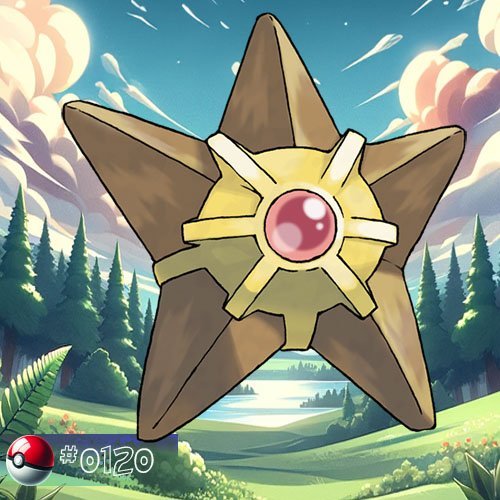Staryu
Staryu is a Water-type Pokémon known for its star-shaped body and the jewel core at its center. It’s often found in oceans and seas.

| National Pokedex No: 0120 |
| Type: |
| Category: Star Shape Pokémon |
| Height: 0.8 m (2′07″) |
| Weight : 34.5 kg (76.1 lbs) |
| Gender: Genderless |
| Abilities/Hidden abilities:
Illuminate or Natural Cure/Analytic |
Biology
Physical Characteristics
Staryu is a Pokémon characterized by its unique star-shaped body structure. The core at its center, known as the “jewel,” is a reddish-brown or golden color and serves as the source of its power. This core is said to possess the ability to shine in various vibrant colors.
The five arms or appendages surrounding the core are flexible and can be extended or contracted, providing Staryu with remarkable agility in water. The glossy surface of its body adds to its streamlined appearance, aiding in swift underwater movements.
Despite its star-like shape, Staryu lacks facial features commonly found in other Pokémon. Instead, it relies on its core and appendages for communication and expression. This Pokémon’s elegant and fluid motions make it a captivating sight, especially when gliding through aquatic environments.
Behaviour
Staryu exhibits distinctive behaviors that align with its aquatic nature. Staryu is an adept swimmer, effortlessly navigating through water with its five flexible arms and streamlined body. Its agility allows it to move swiftly and gracefully. Staryu can be found at various depths in the ocean, showcasing its adaptability to different aquatic environments. It is equally comfortable near the surface or in deeper waters.
Staryu is attracted to and can move towards light sources, a behavior known as phototaxis. This trait is often observed in its natural habitat, where it can be found near the ocean’s surface.
While lacking facial features, Staryu communicates through subtle movements of its core and appendages. It can convey emotions or intentions using these flexible limbs, showcasing its non-verbal communication skills.
Staryu has defensive mechanisms to protect itself. When threatened, it can withdraw its limbs into its core, becoming a more compact and resilient form. This defensive tactic helps it endure attacks from predators.
Staryu’s core has a unique ability to shine in vibrant colors, especially when it’s agitated or during moments of intense activity. This luminescence might serve multiple purposes, including communication and attracting prey or potential mates.
Staryu is known to be social, often forming groups or clusters with other Staryu. This behavior suggests a level of cooperation or mutual benefit in their interactions.
These behaviors collectively contribute to Staryu’s success in its underwater habitat, allowing it to navigate, communicate, and defend itself effectively.
Evolution
Staryu evolves into Starmie when exposed to a Water Stone. Here are the details of Staryu’s evolution.
Staryu is a Water-type Pokémon characterized by its star-shaped appearance with a central core and five appendages. Staryu does not evolve through leveling up but requires a specific evolutionary item, the Water Stone, to undergo its evolution.
As we mention to evolve Staryu into Starmie, a Water Stone must be used on Staryu. The Water Stone is a special evolutionary item that induces the evolution of Water-type Pokémon. It’s a one-time use item, and once applied to Staryu, the evolution is triggered instantly.
Starmie is a Water/Psychic-type Pokémon and is characterized by a central core encased in a larger, star-shaped body with additional appendages. Starmie gains enhanced stats and a dual typing (Water and Psychic) upon evolution. This evolution often results in increased overall power and versatility in battles.
Starmie represents the final evolutionary stage of the Staryu evolutionary line. Starmie itself does not evolve into another Pokémon. Evolution via a Water Stone is irreversible. Once Staryu evolves into Starmie, it cannot revert to its previous form. Evolution often brings a substantial increase in a Pokémon’s base stats, making Starmie a more formidable and versatile Pokémon compared to its pre-evolutionary form.
In summary, Staryu evolves into Starmie when exposed to a Water Stone, resulting in a stronger and more advanced Pokémon with additional typing.
Appearances
Anime Main Appearances
Misty’s Staryu
Staryu serves as a key member in Misty‘s battle lineup across the original series, first appearing in the episode ”Clefairy and the Moon Stone”. Its debut episode also marks the introduction of the Staryu species. Misty’s Staryu makes subsequent appearances in her cameo arcs during Pokémon the Series: Ruby and Sapphire and Pokémon the Series: Sun & Moon.
Other appearences include episodes:
- ”The Great Eight Fate!” (Juan showcased two Staryu in his Sootopolis City Water Exhibit. Team Rocket captured them along with Juan’s other Pokémon, but together, they managed to escape.)
- ”Shooting Star” (In Hoopa’s Surprise Ring Adventures short a Staryu accidentally knocked Ash and Pikachu away, while another one sent Hoopa flying.)
- ”The Power of Us” (Toren loaned a Staryu to Callahan for the Pokémon Catch Race.)
Anime Minor Appearances
In ”Bulbasaur and the Hidden Village”, a Staryu was cared for by Melanie. It later appeared in a flashback in ”Bulbasaur… the Ambassador!”. Additionally, Staryu sightings include ”Battle Aboard the St. Anne”, ”Pokémon Fashion Flash”, ”The Breeding Center Secret,” ”Pikachu’s Vacation”, and Marina’s fantasy in ”Bye Bye Psyduck”.
In ”The Power of One”, a Staryu sensed the disturbance caused by Lawrence III. In ”The Joy of Water Pokémon”, a Staryu received special care in a salt bath at the Pokémon Center by Lake Lucid. ”Gonna Rule The School!” showed the Pokémon Trainers’ School lending a Staryu to its underage students for lessons. Additionally, in ”One Team, Two Team, Red Team, Blue Team!”, a student utilized a Staryu provided by the Pokémon Summer Academy in the second leg of the Pokémon Triathlon.
Other appearances include the Japanese credits of ”Pikachu’s Rescue Adventure”, ”Around the Whirlpool”, ”Lucario and the Mystery of Mew”, ”All for the Love of Meloetta!”, ”Going for the Gold!”, ”Pikachu and the Pokémon Music Squad”, ”Yo, Ho, Ho! Go, Popplio!”, ”The Sun, the Scare, the Secret Lair!”, ”A Shivering Shovel Search!”, ”I Choose You!”, ”Alola, Kanto!”, ”Securing the Future!”, ”This Could be the Start of Something Big!”, ”For Sure! ‘Cause Sprigatito’s with Me!”, and ”The Treasure After the Storm!”.
Multiple Staryu appeared in the episodes:
- ”Showdown at the Po-ké Corral” (living at the Laboratory of Professor Oak), ”The Rivalry Revival” (reappeared)
- ”Piplup, Pansage, and a Meeting of the Times!”
- ”Expedition to Onix Island!” (residents of a deserted island)
- ”Kalos, Where Dreams and Adventures Begin!”
- ”Pikachu’s Exciting Adventure!” (three of them)
- ”Legend? Go! Friends? Go!” (three of them)
A Trainer’s Staryu appeared in the following episodes:
- ”Dueling Heroes” (participated in the Whirl Cup)
- ”Lost at the League!”
- ”Summer of Discovery!” and ”Foggy Pokémon Orienteering!” (participated in the Pokémon Summer Camp), ”Day Three Blockbusters!” (reappeared in a flashback) and ”Battling Into the Hall of Fame!” (reappeared in a fantasy)
- ”Alola to New Adventure!” (two of them, one owned by Trainer)
- ”I Choose Paradise!” (one owned by Trainer)
- ”Battle Royal 151!” (participated in the Battle Royal)
- ”Exhibition Unmasked!”
- ”The Cuteness Quotient!”
- ”On Land, In the Sea, and to the Future!” (participated in the Kids Marine Athletic Race)
Manga Appearances
Ash & Pikachu
In this manga a Staryu owned by Misty appeared in ”The Grand Rhydon Plan”.
Pokémon Adventures
Staryu made its debut in the Red, Green & Blue arc as one of Misty’s Pokémon, showcasing its defensive prowess against an enraged Gyarados in ”Gyarados Splashes In!” and Koga’s Rhydon in Raging Rhydon. In ”The Kindest Tentacruel”, a Staryu featured in Yellow’s fantasy, envisioning evolution through an Evolution Stone. During ”Breath of the Dragonair Part 1”, a Trainer-owned Staryu participated in a surfing contest, only to face interruption when Lance took control of the prize—a Dragonair.
In ”Surrounded by Staryu”, Crystal encounters a playful herd of twelve Staryu, creating a dodecahedral shell to play with Bill and Farfetch’d. Crystal, using the Pokémon Portable Transport System, intervenes, later finding the Staryu playing with Professor Oak in Cherrygrove City.
During ”The Last Battle XIII”, a Staryu participates in the fight in Ilex Forest. Jack, a Swimmer, owns a Staryu named Starry in ”Not So Fetching Feebas”, aiding in luring Feebas. In ”Double Trouble with Dialga and Palkia IV”, a Staryu appears in a fantasy. And a Trainer’s Staryu is featured in ”Deprogramming Porygon-Z”.
Pokémon Gold & Silver: The Golden Boys
In this manga one Staryu was seen in ”Let’s Aim For The Goal!” and several others appeared in ”Let’s Survive This Sea Battle”.
Pokémon Journeys: The Series
In this manga two Staryu were seen in ”Legend? Check! Friends? Check!”.
Game data
Stats
Location
| Game version | Location |
|---|---|
| Pokémon Red and Pokémon Blue | Routes 19, 20 and 21, Cinnabar Island, Seafoam Islands |
| Pokémon Yellow | Routes 19, 20 and 21, Pallet Town, Vermilion City, Cinnabar Island, Seafoam Islands |
| Pokémon Gold and Pokémon Silver | Routes 19, 20, 21, 34, 40 and 41, Cherrygrove City, Cianwood City, Olivine City |
| Pokémon Crystal | Routes 19, 20, 21, 34, 40 and 41, Cherrygrove City, Cianwood City, Olivine City, Union Cave |
| Pokémon Ruby and Pokémon Sapphire | Lilycove City |
| Pokémon FireRed | Trade |
| Pokémon LeafGreen | Pallet Town, Vermilion City, Cinnabar Island, One Island, Five Island, Icefall Cave |
| Pokémon Emerald | Lilycove City |
| Pokémon Colosseum | Trade |
| Pokémon XD | Trade |
| Pokémon Diamond and Pokémon Pearl | Sunyshore City, Canalave City |
| Pokémon Platinum | Sunyshore City, Canalave City |
| Pokémon HeartGold and Pokémon SoulSilver | Routes 19, 34, 40 and 47, Cherrygrove City, Cianwood City, Union Cave B2F, Olivine City |
| Pokémon Black and Pokémon White | Route 13 |
| Pokémon Black 2 and Pokémon White 2 | Route 13, Undella Town, Humilau City |
| Pokémon X | Route 8 |
| Pokémon Y | Trade |
| Pokémon Omega Ruby | Lilycove City, Team Magma Hideout |
| Pokémon Alpha Sapphire | Lilycove City, Team Aqua Hideout |
| Pokémon Sun and Pokémon Moon | Route 7, Hano Beach, Poké Pelago |
| Pokémon Ultra Sun and Pokémon Ultra Moon | Route 7, Hano Beach, Poké Pelago |
| Pokémon: Let's Go, Pikachu! and Pokémon: Let's Go, Eevee! | Routes 18, 19 and 21 |
| Pokémon Sword and Pokémon Shield | Trade |
| Pokémon Brilliant Diamond and Pokémon Shining Pearl | Canalave City, Sunyshore City, Fountainspring Cave, Icy Cave, Riverbank Cave, Still-Water Cavern, Glacial Cavern |
| Legends Arceus | Unobtainable |
| Pokémon Scarlet and Pokémon Violet | Unobtainable |
Staryu's origin name
English: Staryu – The English name “Staryu” is a combination of “star,” referencing its star-shaped appearance, and “you”.
Japanese: ヒトデマン (Hitodeman) – In Japanese, Staryu is known as “Hitodeman,” combining “hitode” (starfish) and “man” (from the English word “man”). The name reflects its star-like shape.
French: Stari – The French name for Staryu is “Stari,” maintaining a resemblance to the English name.
German: Sterndu – In German, Staryu is called “Sterndu,” derived from “Stern” (star) and “du” (you).
Spanish: Staryu – The Spanish name for Staryu is “Staryu,” identical to the English name.
Italian: Staryu – In Italian, Staryu retains its English name as “Staryu.”
Korean: 별가사리 (Byeolgasari) – The Korean name for Staryu is “별가사리,” which translates to “starfish.”
Chinese (Simplified): 海星星 (Hǎixīngxīng) – In Simplified Chinese, Staryu is known as “海星星,” where “海” means sea and “星星” means stars.
Chinese (Traditional): 海星星 (Hǎixīngxīng) – The Traditional Chinese name is also “海星星,” maintaining consistency with the Simplified Chinese version.
The names across different languages generally emphasize its star-shaped appearance, incorporating variations of “star” or “sea star” in their translations.



